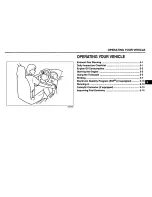
Occupant Restraint Controller (ORC), which
may receive information from the front impact
sensors (if equipped) or other system compo-
nents.
The first stage inflator is triggered immediately
during an impact that requires air bag deploy-
ment. A low energy output is used in less severe
collisions. A higher energy output is used for
more severe collisions.
This vehicle may be equipped with a driver
and/or front passenger seat belt buckle switch
that detects whether the driver or front passen-
ger seat belt is buckled. The seat belt buckle
switch may adjust the inflation rate of the Ad-
vanced Front Air Bags.
This vehicle may be equipped with driver and/or
front passenger seat track position sensors that
may adjust the inflation rate of the Advanced
Front Air Bags based upon seat position.
WARNING!
• No objects should be placed over or near
the air bag on the instrument panel or
steering wheel because any such objects
WARNING!
could cause harm if the vehicle is in a
collision severe enough to cause the air
bag to inflate.
• Do not put anything on or around the air
bag covers or attempt to open them manu-
ally. You may damage the air bags and you
could be injured because the air bags may
no longer be functional. The protective
covers for the air bag cushions are de-
signed to open only when the air bags are
inflating.
• Relying on the air bags alone could lead to
more severe injuries in a collision. The air
bags work with your seat belt to restrain
you properly. In some collisions, air bags
won’t deploy at all. Always wear your seat
belts even though you have air bags.
Front Air Bag Operation
Front Air Bags are designed to provide addi-
tional protection by supplementing the seat
belts. Front air bags are not expected to reduce
the risk of injury in rear, side, or rollover colli-
sions. The front air bags will not deploy in all
frontal collisions, including some that may pro-
duce substantial vehicle damage — for ex-
ample, some pole collisions, truck underrides,
and angle offset collisions.
On the other hand, depending on the type and
location of impact, front air bags may deploy in
crashes with little vehicle front-end damage but
that produce a severe initial deceleration.
Because air bag sensors measure vehicle decel-
eration over time, vehicle speed and damage by
themselves are not good indicators of whether or
not an air bag should have deployed.
Seat belts are necessary for your protection in all
collisions, and also are needed to help keep you
in position, away from an inflating air bag.
When the ORC detects a collision requiring the
front air bags, it signals the inflator units. A
large quantity of non-toxic gas is generated to
inflate the front air bags.
The steering wheel hub trim cover and the upper
passenger side of the instrument panel separate
and fold out of the way as the air bags inflate to
their full size. The front air bags fully inflate in
less time than it takes to blink your eyes. The
front air bags then quickly deflate while helping
to restrain the driver and front passenger.
85
Содержание DODGE CHARGER RWD 2019
Страница 35: ...Automatic Climate Control Overview Uconnect 4 With 7 inch Display Automatic Climate Controls 33...
Страница 36: ...Uconnect 4C 4C NAV With 8 4 inch Display Automatic Climate Controls GETTING TO KNOW YOUR VEHICLE 34...
Страница 179: ...177...
Страница 230: ...228...
Страница 238: ...236...
Страница 239: ...237...
Страница 240: ...238...
Страница 241: ...239...
Страница 242: ...240...
















































